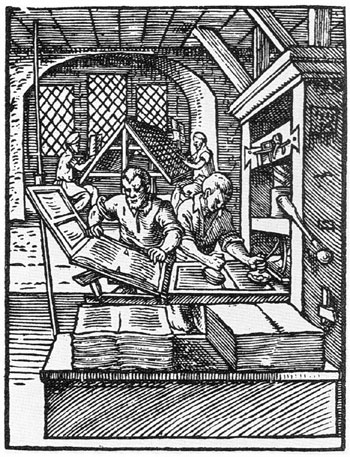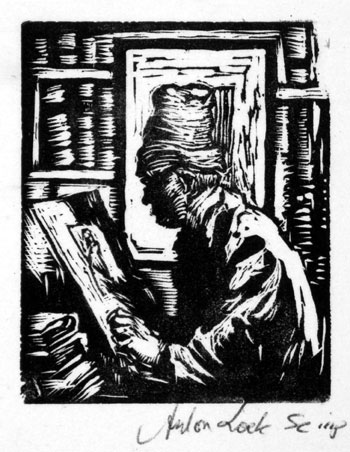Relief
Printing - An Introduction
In
a relief print the design which is to receive
the printing ink is left in relief, protruding
from the block, while the rest of the surface
of the block is cut away around it. Wood
blocks or lino blocks (or for school children
the simple potato) are the usual materials
from which the matrix for a relief print
is composed).
Firm,
vertical pressure applied evenly from above
is required to print the image.
The
earliest woodcuts (and more recent ones)
were printed just with hand-pressure. After
inking the block is either inverted and
pressed down onto the paper, like a stamp,
or the paper is laid face down on top of
the inked block and the sheet rubbed from
the back with a spoon or similar tool.
With
the invention of movable type, about 1450,
and the establishment of printing houses,
printmakers adopted the letterpress-printer’s
screw or lever press (the platen press)
for printing their pictorial blocks.
Thick,
sticky ink, which will not run into the
hollows, is applied by means of dabbers
(leather-covered wooden balls with handles
for manipulating them) to the parts of
the block left in relief.
The
block is positioned on the bed of the press
(the flat movable base), dampened paper
placed over the block and the bed slid
into position under the platen.
Descending
pressure is applied from above by the platen
(plate) which is lowered in a kissing action
by means of a screw mechanism worked by
the printer pulling the lever arm towards
him.

The
example above is “The Printer” from
Jost Amman’s illustrations to Hartmann
Schopper’s book of trades “Aller
Standen auf Erden”. Jost
Amman’s woodcut (1568) shows a letterpress
printer at work. The same press was used
to print 16th century woodcut images. The
double tympanum press is open while ink
is being dabbed onto the type face. A printed
sheet is being removed to be replaced by
a fresh sheet. For printing the hinged
frisket will be folded over the paper,
thus protecting the margins of the sheet,
and the whole folded into position on top
of the matrix holding the typeface. The
screw mechanism with its lever arm and
the platen beneath which it operates can
be seen clearly.
Though
this is a 16th century press, the principle
of a platen descending to press onto the
paper laid on the inked block is the same
in a modern press, and the design itself
has changed very little.

Anton Lock’s "The
Print Connoisseur", woodcut |